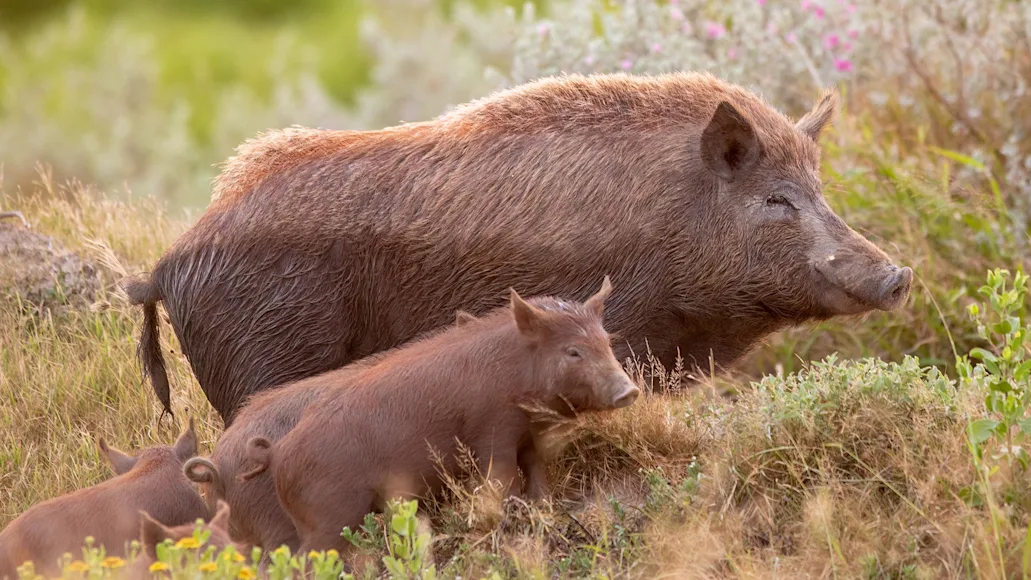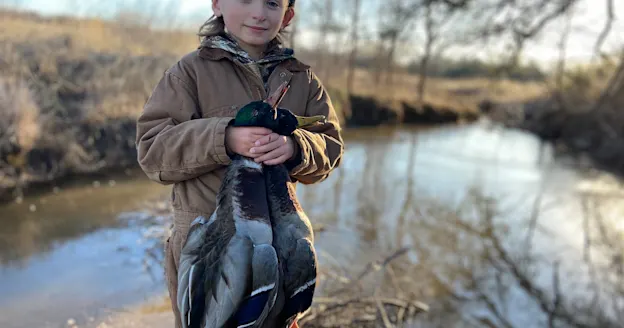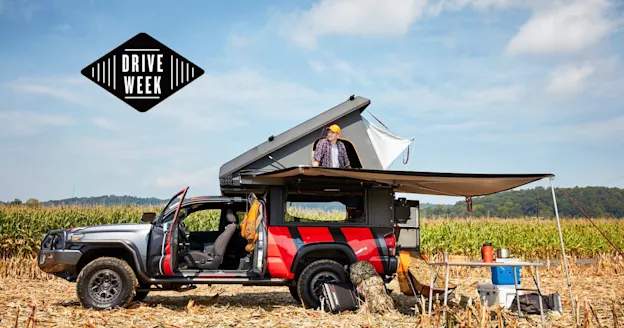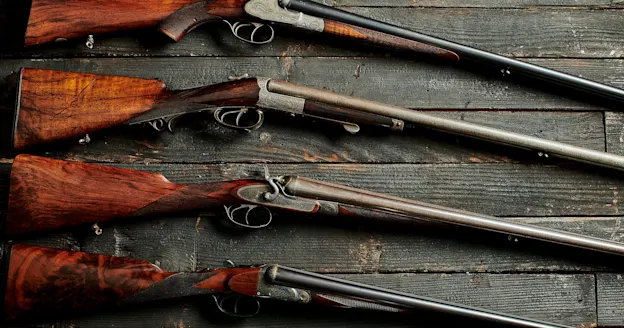AT FIRST, the critter feeding in the powerline caused me to skip a breath and kneel behind a blackberry bush for cover. It had been a slow morning of turkey hunting at Land Between the Lakes (LBL) National Recreation Area, and for a second, I thought my luck had changed. But I quickly realized what I was looking at. The pitch-black form wasn’t a giant, strutting gobbler but a wild boar, the second one I’d seen that morning.
With a good wind, I probably could’ve gotten close enough to kill that pig with a TSS turkey load. But in LBL, like in many places with burgeoning hog problems, it’s illegal for hunters to shoot wild pigs. Virtually all managers who’ve dealt with invasive hogs agree that hunting does little to control their numbers and can even educate the animals, making them more difficult to trap. Many also say that it’s the glamorization of pigs as game animals that have incentivized people to release hogs into new areas, possibly including LBL. I understand all of that in theory, but I also know that I’ve seeing hogs and letting them walk in LBL for eight years now—and I can’t help wondering if not shooting them is actually doing any good.
Pig Policy
In LBL and many other public lands across the Midwest and Southeast, hog control is primarily the responsibility of the USDA’s Animal and Plant Health Inspection Service (APHIS) Wildlife Services. In LBL, that comes with support from the U.S. Forest Service, which oversees the land. Since 2016, APHIS Wildlife Services has used a blend of trapping and aerial shooting to kill 2,221 pigs in LBL, and they say that they’re on track to eradicate them.
But not everyone is so sure. I’ve been hunting LBL for 20 years, and I spend 30-plus days there every season. This past spring, I saw more wallows, rooted-up hillsides, and live hogs than I ever had previously. Virtually every deer hunter I know who runs trail cameras in LBL has pictures of hogs, and I’ve talked to cyclists and hikers who routinely encounter them on trails. Kerry Underhill, whose family has row-cropped portions of LBL since the 1960s, is considering giving up his farming contract there because he can’t compete with the hogs. Recent plantings have been almost a total loss. “Last year, we planted corn but never even put a combine in most of the fields (to get a harvest),” he tells me. “The hogs go right down the rows of seed and eat all of it.”
Meanwhile, some in the private hog-control industry point to federal pig-control operations like the one in LBL as being models of government inefficiency. Hog control isn’t cheap. In the 2018 Farm Bill, $75 million of taxpayer’s money was allocated to the Feral Swine Eradication and Control Pilot program, some of which has been used in LBL. But most of the work being done here, which costs an estimated $100,000 per year, comes from the LBL’s general fund, which is overseen by the U.S. Forest Service.
The bottom line is that the government spends huge amounts of money trying to control the invasive pig problem on many of the country’s state and federal public lands, and the situation at LBL is a good example of how they seem to be going about it. Similar programs that outlaw shooting pigs on public lands and instead depend on Wildlife Services for pig control are being implemented throughout most of Tennessee, as well as in Missouri and Kansas. So the question is: Is this policy working?
Hog History
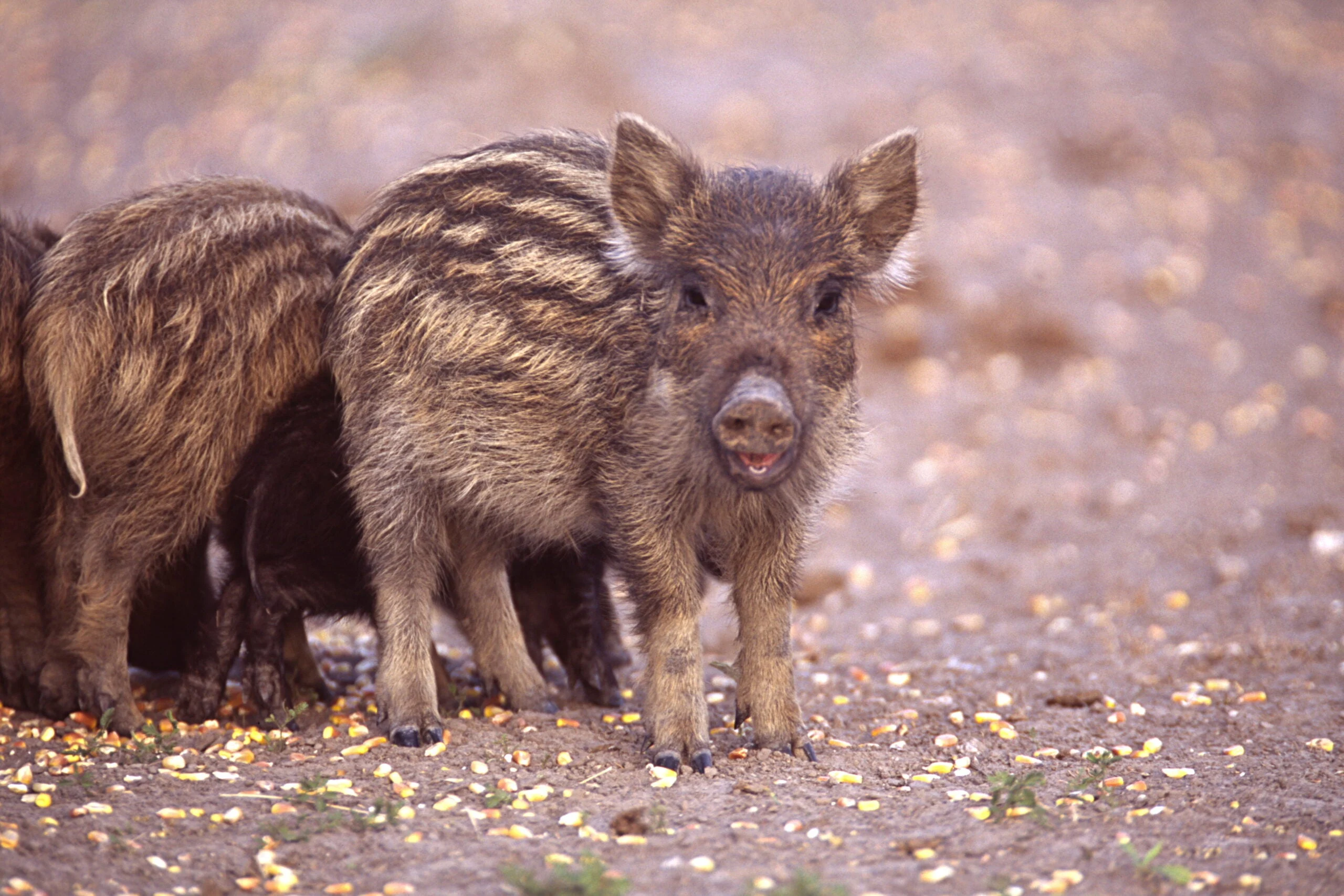
Wild hogs can have as many as a dozen piglets every year. Brian Barnes / Adobe Stock
Land Between the Lakes National Recreation Area is one of the best-known public-land areas east of the Mississippi River, with 1.7 million annual visitors. It’s composed of more than 170,000 contiguous acres split by the Kentucky-Tennessee state line and is uniquely situated between the Cumberland and Tennessee Rivers, which were impounded to create Barkley and Kentucky Lakes, making it the country’s largest inland peninsula.
John Westbrook is the environmental stewardship department manager for LBL under the Forest Service, which has managed the area since 1999. Originally from Georgia, Westbrook grew up running hog dogs and admits that he still loves hog hunting to this day. In fact, he says, managing LBL’s deer herd and hunting the hogs was one of the original reasons he took the job years ago. He says the first hogs were reported in LBL around 2003, and up until 2015, hunters were allowed to shoot them. For years the population remained static, but that changed around 2017, when there was a noticeable increase in hog numbers.
“Around 2016 and 2017, hog hunting came in vogue. You had helicopter hog hunting in Texas. You had Brian Quaca the Pigman. You had all these entertainers who were glamorizing hog hunting,” Westbrook says. “That’s when we noticed an uptick in sightings. I’m not going to say more hogs were introduced, but there was an uptick. Anyone who’s been around hogs knows that once they’re in, they dig in like a tick. If you’re not removing 70 or 80 percent of the population annually, you’re behind the eight ball—and we quickly found ourselves behind the eight ball.”
Westbrook came to realize that hunting the hogs wasn’t getting rid of them—and that it may have been making the problem worse. “Even with the best dogs, if you catch three hogs out of a sounder, you’re doing well,” he says, noting that the rest of the sounder simply relocates. “With trapping (as performed by Wildlife Services), it’s unusual to catch only one or two hogs, and it’s unlikely to be so disruptive that the hogs are moving off.” Westbrook says that in the time since he first came to the area, his understanding of the problem and the ability of hunters to help solve it had evolved. In 2015, based on lack of hunter success, the official policy took a turn.
“We made hog hunting illegal,” he said.
The Current “Situation”
Early trapping efforts removed 70 hogs in 2018 and 124 in 2019, but it wasn’t enough to keep up with the problem. So, aerial shooting was added to the toolbox beginning in 2020. “The numbers [of pigs killed] picked up significantly when we brought in the helicopter,” says Brad Robbins, district supervisor for Wildlife Services in the Jackson, Tennessee, district. “For aerial gunning to work for control, you need access to large, contiguous acres, which LBL provides. We do it during winter, and if the pigs move at all, it’s hard for them to not be seen.”
Feral hogs breed year-around and can have two litters of four to six piglets per year. Piglets are sexually mature in as few as six months. Theoretically, 10 pigs can become more than 100 in just a year’s time.
In 2020, between trapping and aerial gunning, officials killed 534 hogs in LBL. Efforts were stalled in 2021 due to COVID restrictions, but they resumed in 2022 and 2023. A Forest Service press release on the LBL website says: “In 2020, the first year of aerial operations at LBL, numerous sounders of feral swine were observed. Since then, feral swine and damage observations have consistently decreased resulting in multiple flights with few or no feral swine or associated damages observed. While these observations are anecdotal, they suggest the ongoing efforts are reducing the number of feral swine and associated damages at LBL.”
Westbrook’s take on the current situation, however, is more sobering. “It’s hard to say that the pig situation is not better now than it was,” he says. “But are we where we want to be? The answer is no.”
Advice From a Pro
There’s no denying the effectiveness of aerial shooting, but some think the government trapping programs like the one at LBL could be better. A popular saying in the hog-control world is, “It doesn’t matter how many pigs you kill, it matters how many are left behind.” Feral hogs breed year-around and can have two litters of four to six piglets per year. Piglets are sexually mature in as few as six months. Theoretically, 10 pigs can become more than 100 in just a year’s time.
Nobody knows how many pigs are in LBL, but to Rod Pinkston, measuring the success of any hog control effort only by numbers killed doesn’t say much. Pinkston is the founder and CEO of Jager Pro hog control systems in Georgia, and he essentially created the private hog-control industry.
“When people say, ‘Pig numbers are down, and here’s all the pigs we’ve killed as proof,’ I call bullshit,” Pinkston says. “The 30 to 40 percent of the pigs that survive learn and breed. It blows my mind how state and federal entities can report numbers of pigs taken without showing efficiencies.”
Jager Pro’s trapping operations are all documented on video, with meticulous records of the number of hogs observed and captured. The company routinely documents capture rates of more than 90 percent. Pinkston noted that his company just completed a 24-month project on a 5,000-acre property near the Flint River in Georgia, for example, where they removed all of the 636 pigs that were documented.
This video fro Jager Pro shows the company’s process for trapping entire sounders.
The company’s signature trap relies on wire panels and a remote drop gate to capture pigs that have been conditioned to visit a timed feeder. During the conditioning period, individual pigs in sounders are counted and monitored via trail camera. Once pigs are comfortable entering the trap, and once operators know all the pigs are inside, the gate is dropped, either via a remote cellular signal or, in areas with limited cell service, by on-site staff watching the traps in person.
Pinkston says conditioning pigs to timed feeders is an important part of the process. “Our digital timer activates the feeder at the same time every day with the exact same amount of corn,” he says. “It’s pretty easy to train pigs to come to it, and you can monitor their numbers. That’s why every one of our videos starts with how many pigs are in a sounder and ends with how many are dead behind the gate.”
The trapping techniques used by Wildlife Services look different, at least in LBL. Robbins says the pigs there are especially nomadic due to the volume of human foot traffic. “A lot of the pigs here have distinctive color patterns and are easy to identify,” he says. “We’ve had sounders on camera in one place one night and then on another camera 2 miles away two days later. We also have a problem in that there’s no allegiance to bait. These pigs seem ready to leave at any time.”
Robbins also says that because there is so little cell service in LBL, and because the pigs are so flighty, Wildlife Services personnel use a more mobile trapping approach, opting to scatter bait by hand at most sites and to use passive net traps, which pigs can root their way into but then can’t get back out of. Robbins says it’s effective for catching large groups. “A sow walks in and feeds, and shoats follow, and they don’t realize they’re stuck until they’ve eaten all the bait and try to get out.”
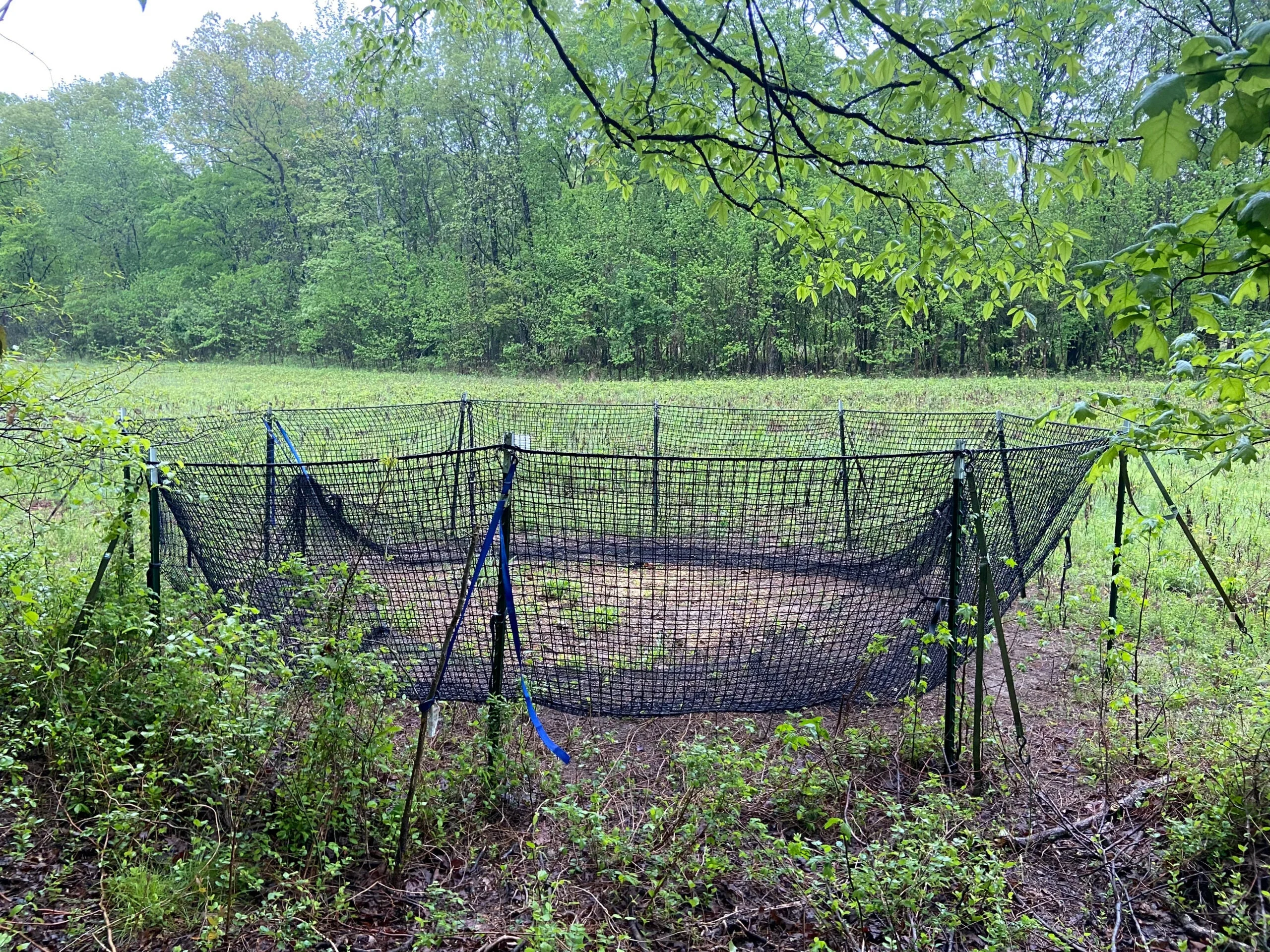
A passive net trap on LBL, which the author came upon during this past spring’s turkey season. Will Brantley
As for timed feeders? “We have used them, but in LBL, we try to keep our footprint small because we’re on the move,” Robbins says. “Setting up a big feeder means more equipment to move, and more of an investment in time. Baiting by hand and [using the net trap], seems to be the most efficient for us.”
Despite LBL’s immense size, there’s only one Wildlife Services trapper dedicated to full-time hog control in LBL, though he does have part-time help on occasion. Robbins insists that, in conjunction with the aerial gunning efforts, one full-time man is enough. Though the district doesn’t maintain a ledger that details pig-control efforts, Robbins says the trapper is very detail-oriented.
“When he gets a sounder on bait, he sets cameras to take pictures quickly, and he watches them. Once he’s satisfied about how many pigs he’s dealing with, he tries to catch them. Sometimes it’s hard to tell for sure how many are there because they blend together, but he knows the highest potential number, and if he doesn’t catch that number, he knows about how many are left in the sounder.”
Pinkston has his doubts. “I haven’t seen LBL, but there’s no way one guy can cover 170,000 acres if you’re trying to eliminate the pig population,” he says. “I wouldn’t send one guy to do 20,000 acres. To do it right, you need eight or 10 guys, and it would take 18 to 24 months. But it being on a peninsula should make the pigs easier to catch.”
How Hunters Could Help
Pinkston thinks there’s a potential solution to eliminating hogs from large public areas, like LBL, that could even involve hunters. He points out that both aerial gunning and trapping are most effective in the late winter and early spring. Meanwhile, deer hunters are in the woods in the fall, when hogs are more difficult to pattern on bait and virtually impossible to see from the air before the leaves fall.
“If we’ve already got a bunch of deer hunters out there in the woods when the acorns are falling and the pigs are scattered, why not make them part of the solution and let kill as many adult pigs as they can during deer season,” Pinkston says. “And then come December and January, when the leaves are gone, the hunting stops. That’s when Wildlife Services should step in and do what they do best, which is aerial gun. Again, they’ll take mostly adults. And when they’re done, private trappers can follow up immediately and be trapping mostly juvenile animals. You put in an annual cycle of programs that work, where everybody is documenting their success and holding people accountable. To me, everyone takes a win from that.”
As for the hunting portion, Pinkston says the important thing would be to crack down on anyone moving and releasing pigs. “I think given the opportunity, most hunters will do the right thing. They know pigs are a bad thing and don’t want them taking over.”
Yet Wildlife Services insists they’re on the right track—and that reintroducing hunting intp the mix is not part of the solution. “Look at the Southern states that have allowed pig hunting. They’ve given up on the opportunity to eradicate them,” Robbins says. “We have the opportunity to remove them from here. If incidental take was allowed, then you have pig hunters. It’s all or none; you can either shoot pigs here or you can’t.” He adds, “I think we’ll see the end of feral swine in LBL before I retire.”
As ever more states (and even Canada) are invaded by feral swine and hunters continue to be asked to pass up pigs while waiting patiently for results that don’t seem forthcoming, a lot is riding on whether or not Robbins’ prediction comes true.

